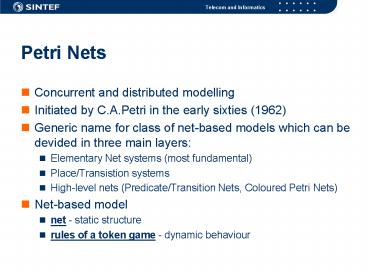Petri Nets PowerPoint PPT Presentation
Title: Petri Nets
1
Petri Nets
- Concurrent and distributed modelling
- Initiated by C.A.Petri in the early sixties
(1962) - Generic name for class of net-based models which
can be devided in three main layers - Elementary Net systems (most fundamental)
- Place/Transistion systems
- High-level nets (Predicate/Transition Nets,
Coloured Petri Nets) - Net-based model
- net - static structure
- rules of a token game - dynamic behaviour
2
Three layers
3
Static the net
- Build up from places and transitions,
- Arrows between them (never from place-gtplace or
from transition-gttransition)
4
Dynamic the rules of a token game
- Start configuration (Initial Configuration)
- A transition t can fire if all input places of t
contain tokens and all output places of t are
empty
5
Local states and neighbourhood
6
Definition
- A net is triple N ( P, T, F), where
- P and T are finite sets with P ? T ?,
- F ? (P ? T) ? (T ? P),
- for every t ? T there exists p, q ? P such that
(p, t), (t, p) ? F, and - for every t ? T and p, q ? P, if (p, t), (t, p) ?
F, then p ? q.
7
Example
- The net N (P, T, F) with
- P p1, p2,
- T t1,
- F (p1, t1), (t1, p2)
8
Producer - Consumer Problem
c1
p1
producing
emptying
p2
c2
buffer
consuming
filling
9
Mutual Exclusion Problem
A(1)
B(1)
in1
in2
A(2)
B(2)
out2
out1
B(3)
A(3)
d1
d2
10
A(1) / B(1)
A(1) Component A is waiting to print
A(2) Component A is printing
A(3) Component A has finished printing
Sequential Configuration Graph
11
Fundamental Situations
- 1. Causality
- 2. Concurrency
- 3. Conflict
- 4. Confusion
12
1. Causality
13
2. Concurrency
14
3. Conflict
15
4. Confusion
16
Application areas of Petri Nets
- Modelling of concurrent distributed processes
- Analysis of concurrent distributed processes
- Analysis of performance
- Process Algebra
- Production Systems
- Computer Supported Cooperative Work (CSCW)
- Digital Hardware Design
PowerShow.com is a leading presentation sharing website. It has millions of presentations already uploaded and available with 1,000s more being uploaded by its users every day. Whatever your area of interest, here you’ll be able to find and view presentations you’ll love and possibly download. And, best of all, it is completely free and easy to use.
You might even have a presentation you’d like to share with others. If so, just upload it to PowerShow.com. We’ll convert it to an HTML5 slideshow that includes all the media types you’ve already added: audio, video, music, pictures, animations and transition effects. Then you can share it with your target audience as well as PowerShow.com’s millions of monthly visitors. And, again, it’s all free.
About the Developers
PowerShow.com is brought to you by CrystalGraphics, the award-winning developer and market-leading publisher of rich-media enhancement products for presentations. Our product offerings include millions of PowerPoint templates, diagrams, animated 3D characters and more.

